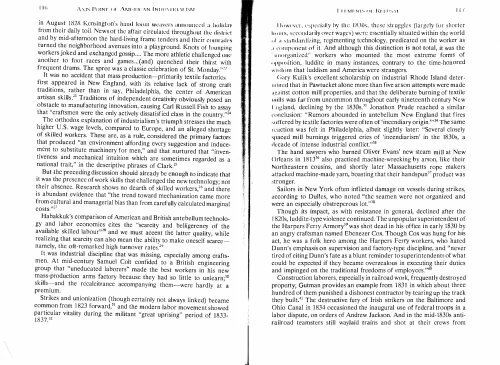CONTENTS - ouroboros ponderosa
CONTENTS - ouroboros ponderosa
CONTENTS - ouroboros ponderosa
You also want an ePaper? Increase the reach of your titles
YUMPU automatically turns print PDFs into web optimized ePapers that Google loves.
J\dS "( )jN-.- f,, · AMI·',U·r\N INIII I"> 'IO:\l ISM<br />
in August IK2X Kensington's hand 100111 weavers alillOUllccd a JHllidIY<br />
from their daily toil. News of the affair circulateo throughout thl' distrirt<br />
and by mid-afternoon the hard-living frame tenders and their eOlnrad,'"<br />
turned the neighborhood avenues into a playground. Knots of loungill :<br />
workers joked and exchanged gossip .... The more athletic challenged onl'<br />
another to foot races and games ... (and) quenched their thirst wilh<br />
frequent drams. The spree was a classic celebration of St. Monday,"'"<br />
It was no accident that mass production-primarily textile factories<br />
first appeared in New England, with its relative lack of strong craft<br />
traditions, rather than in say, Philadelphia, the center of American<br />
artisan skills ." Traditions of indepenoent creativity ohviously posed an<br />
obstacle to manufacturing innovation, causing Carl Russell Fish to assay<br />
that "craftsmen were the only actively dissatisfied class in the country.""<br />
The orthodox explanation of industrialism's triumph stresses the much<br />
higher U.S. wage levels, compared to Europe, and an alleged shortage<br />
of skilled workers. These are, as a rule , considered the primary factors<br />
that produced "an environment affording every suggestion and induce<br />
ment to substitute machinery for men," and that nurtured that "inven<br />
tiveness and mcchanical intuition which are sometimes regarded as a<br />
national trait," in the descriptive phrases of Clark."<br />
But the preceding dicusion should already be enough to indicate that<br />
it wa the presence of work kills that challenged the new technology; not<br />
their absence. Research shows no dearth of killed workers,26 and there<br />
is abundant evidence that "the trend toward mechanization came more<br />
from cultural and managerial bias than from carefully calculated marginal<br />
costs.,m<br />
Habakkuk's comparison of American and British antebellum technolo<br />
gy and labor economics cites the "scarcity and belligerency of the<br />
available skilled labour"'" and we must accent the latter quality, while<br />
realizing that scarcity can also mean the ability to make oneself scarce<br />
namely, the oft-remarked high turnover rate.29<br />
It was industrial discipline that was missing, especially among crafts<br />
men. At mid-century Samuel Colt confided to a British engineering<br />
group that "uneducated laborers" made the bet worker in his new<br />
mass-production arms factory becaue they had so little to unlearn;lO<br />
skills-and the rccalcitrance accompanying them-wcre hardly at a<br />
premium.<br />
Strikes and unionization (though ccrtainly not always linked) became<br />
common from 1823 forward," and the modern labor movement showed<br />
particular vitality during the militant "great uprising" period of 1833-<br />
1837 -"<br />
I II·MI'NI:-. fll 1






